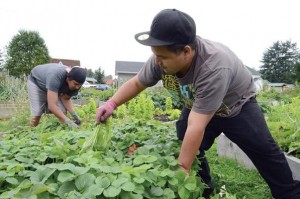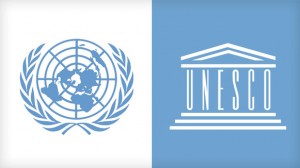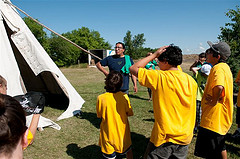First Nations Technology Council
Description:
The First Nations Technology Council (FNTC) supports the full integration of technologies to improve the lives of all First Nations (FN) in BC. It was created by a FN Summit Resolution to develop a technology plan for the FN of BC. The plan includes ensuring all 203 FN groups are connected with high speed broadband and have access to the necessary support to access and maintain these technologies.
The site has several resources, training opportunities, and useful links which includes an open discussion forum on First Nations Technology in BC. There people can share resources and engage in meaningful discussion. The office of the FNTC is located in West Vancouver (on the Squamish Nation).
~ Ryan
October 17, 2011 No Comments
First Nations in British Columbia Portal
http://www.fnbc.info/content/about-first-nations-bc-portal
Description:
The First Nations of British Columbia Portal (FNBCP) was put together in partnership between the First Nations Technology Council, New Relationship Trust and several other community groups and organizations throughout BC. The focus of the FNBCP is to provide a resource where individuals can communicate, share ideas, experiences and research key documents pertinent to First Nations (FN) in BC.
Features of the Portal include, scholarship applications, job postings, News & Events, Events Calendars, etc. all of which are kept up-to-date by the administrators of the FNBCP. It also has a link to Indigenous Views – a blog covering issues important to FN people.
~ Ryan
October 17, 2011 No Comments
First Nations Summit
Description:
The First Nations Summit (FNS) is made up of First Nations (FN) and Tribal Councils in BC. The Website provides a venue for FN in BC to access information regarding Treaty negotiations (past, present and future) as well as other issues important to the FN in BC.
The site also provides a calendar of events, useful links, information and a library of catalogued documents and resources important to FN in BC.
~Ryan
October 17, 2011 No Comments
Ustlahn Community Kitchen
 http://www.nsnews.com/harvest+healing/5490289/story.html
http://www.nsnews.com/harvest+healing/5490289/story.html
Description:
I first learned about this organization by way of a local newspaper in my community, the North Shore News. There was an article titled: A harvest of healing: Growing food and changing lives in the Squamish Nation from October 3, 2011. This organization provides many services to the members of the Squamish Nation which include improving the health/wellness of its community, operating a community kitchen (which provides healthy meals) and cultivating a community garden. The organization focuses on youth participation to tend the garden as well as train them with the culinary skills necessary to maintain the community kitchen. The main focus of the kitchen is providing healthy meal planning and food preparation skills (including food safety) that will promote a healthy lifestyle. Many people taking advantage of the community kitchen cannot afford to prepare meals for themselves or lack the skills necessary to do so.
~ Ryan
October 17, 2011 No Comments
Longhouse Media
http://www.longhousemedia.org/
Description:
As part of our course readings (Discussion #8: Traditional Culture, Technology and Youth), I came across Longhouse Media. The mission of Longhouse media is “to catalyze indigenous people and communities to use media as a tool for self-expression, cultural preservation, and social change”.
They offer a program called Native Lens which teaches Indigenous Youth media and filmmaking skills. They teach Indigenous youth to tell their own stories through digital mediums thus ending the stereotypes that have been perpetuated by mainstream media.
Personally I found the video March Point to be very intriguing hence my search for the website and organization.
~ Ryan
October 17, 2011 No Comments
Using Technology To Preserve A Culture Rather Than Destroying It
Technology can be utilized to preserve a culture rather than destroy it
Perhaps the following statement is too simplistic in nature but I assume that every race, culture and community share the same struggle when it comes to the growing disconnect between its generations. As technology (ie: internet, computers, web 2.0, social media, etc.) have entered the discussion this divide seems to have increased even more. Not unlike any other culture or community today’s Aboriginal Youth are being raised in a digital age. Without knowledge or prejudice I assume teachers and elders from Aboriginal communities are having similar problems in engaging and connecting with the youth as their non-Aboriginal counterparts do. I also understand that there exists a fear that technology (ie: the internet) may in fact eradicate many traditions and cultural values that the elders hold so dear. Only three weeks into this course I have learned about some of these fears but I hold fast (at this point) to the notion that technology can be used to preserve a culture, not destroy it.
The focus of my weblogs and research will be centered on the assumption that, with respect to Aboriginal youth, technology can be utilized to preserve a culture rather than destroy it. I intend to find examples, articles, and websites that show this to be true. It is vital that my research be authentic and not merely from an ethnocentric perspective. Elders may not share the same passion and enthusiasm for technology as today’s youth do but I feel that if used properly technology can be a valuable tool employed to preserve a culture.
~ Ryan
September 26, 2011 No Comments
The First Peoples’ Project
The First Peoples’ Project
(http://www.iearn.org.au/fp/)
![]()
(click on above image to be redirected to a video on the edutopia.com website explaining a project completed by the Choctaw Tribal School)
Description:
The First Peoples’ Project uses computer technology (and the web) to connect Indigenous youth from around the world. It is a way to encourage and engage students to participate in a form of education that is meaningful, personally relevant and valued. All submissions and stories must be made with the authorization from community leaders and elders therefore nothing is posted without consent which adds to the credibility and authenticity of the project. Unfortunately it appears as though it only ran for 10 years – 2007 being the last year of the project (although I hope I am wrong on this point). I feel as though this is an excellent example of technology being used to bring Indigenous cultures together.
~ Ryan
September 26, 2011 No Comments
Bringing Technology and Tradition Together
LIVING SMART IN TWO WORLDS: Maintaining and Protecting First Nation Culture for Future Generations
(http://smart.knet.ca/Library/GlobalCN-paper.pdf)
Description:
In searching for articles and websites that focus on Aboriginal Youth and Technology I came across this article. This is a paper/presentation presented in 2002 by K-Net (an IT company that worked with 6 different First Nations in the Province of Ontario). Essentially, they looked at ways in bridging the two worlds of technology and tradition. Most importantly, they were successful in doing so. The paper outlines ways in which they were successful and also gives testimonials from various First Nation leaders on its effectiveness.
~ Ryan
September 23, 2011 No Comments
The Role of Technology in Globalization for Indigenous Youth
UNESCO (The Role of Technology in Globalisation for Indigenous Youth)
(http://www.unesco.org/ccivs/New-SiteCCSVI/institutions/jpc-youth/youth-open-forum/Section_for_Youth/Resources_and_tools/Other_documents_on_youth/OXFAM_INTERNATIONAL_YOUTH_PARLIAMENT/Chapter3_Indigenous_Youth.pdf)
Description:
UNESCO (United Nations Educational, Scientific and Cultural Organization) is undoubtedly known by all. But just in case, UNESCO has several goals which include (but are not limited to) ending poverty, building world peace, creating life-long learners, and embracing cultural diversity.
Exploring UNESCO’s website I located a report prepared by OXFAM International. Chapter 5 of this report focuses on the effects of Globalization on Indigenous Youth. There is a section that deals with the ‘Role of Technology in Globalization For Indigenous Youth’ (page 87) that I found particularly appealing because it discusses many things that we have dealt with on our course thus far. Specifically, technology can have both positive and negative effects on Indigenous people and their communities.
~ Ryan
September 23, 2011 No Comments
Red River College’s HAWK Camp for Aboriginal Youth
Red River College’s H.A.W.K. Camp for Aboriginal Youth
(http://redblog.typepad.com/blog/2011/08/aboriginal-youth-soar-at-rrcs-hawk-camp.html)
For the past two summers, Red River College has offered its Hands-On Activity Week for Kids (H.A.W.K.) which is a camp geared towards Aboriginal Youth aged 11-13. The week-long camp introduces Aboriginal Youth to the Construction Trades, Electronics, Mechanical Engineering Technology/Manufacturing, Aviation and Civil Engineering. Many students are getting their first introductions to these fields of study. Besides the hands-on experiences with the trades and technologies, camp-goers also took part in many team building activities, story-telling and drumming, all aimed at bolstering each individual. The camp is free of charge and is available on a first-come-first-serve basis. Participants also receive a free t-shirt as well as lunch and snacks each day.
~ Ryan
September 22, 2011 No Comments




